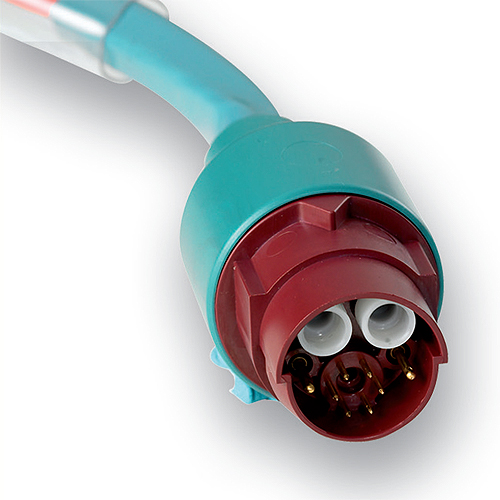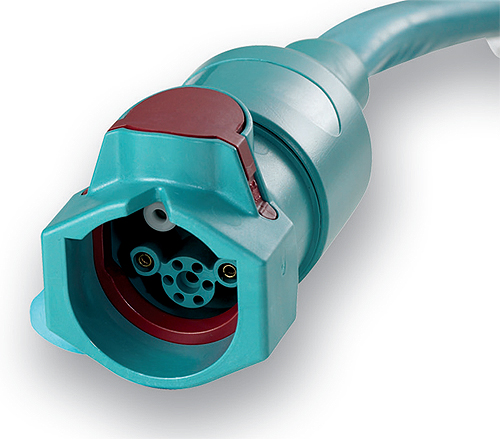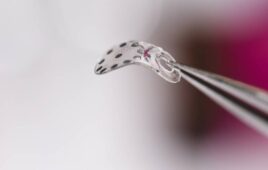By Jaime R. Erickson, Senior Applications Engineer, Colder Products Company
Medical systems continue to become more advanced and complex as newer technologies emerge. With some systems, the “umbilicals” use a variety of different lines for fluidics, pressurized air, vacuum, gasses, and a number of different electronics, such as multi-conductor, coaxial, power, and data cables. With multiple wires, tubes, and hoses, this link between a medical device and its hand piece can become unwieldy, unattractive, and difficult to use, presenting challenges with effectively interconnecting all types of clinical, medical, and surgical devices and tools to them. A new connection approach, however, known as the hybrid connector, effectively addresses these issues.
Common applications where these specialized connections are required include surgical procedures, dentistry, cosmetic skin treatments, eye surgery, and liposuction. Any application where there is a need to transfer liquid, air, power, or data to a remotely used device presents an interconnect challenge. In addition, any time devices are removed and exchanged mid-procedure, there needs to be a clean, safe, and efficient way to “hot-swap.”

The single connection point of an umbilical interconnect makes connecting equipment cleaner in appearance and user friendly. Where multiple hand pieces are used for a particular procedure, a hybrid quick disconnect at the end of their instrument allows for a quick change to a different hand piece or device.
Consider cosmetic laser skin treatment. In this procedure, each control unit comes equipped with several different hand pieces or treatment heads. The treatment heads are physically connected to the controller by means of an umbilical containing a cooling loop for cooling the laser head and multiple conductors for powering the laser and for treatment head sensor monitoring. During a procedure, several different treatment heads may be used to achieve desired results. To reduce the duration of treatment sessions, adding a “hot swap” capability to the end device enables the operator to change treatment heads rapidly and safely.
New technology for more applications
Engineers have discovered that integrating all fluid, air, and electrical connection points into a single, easy-to-use hybrid connector is an alternative solution. Integrating multiple connections allows clinicians and end users to make a simple and secure connection between equipment and hand pieces, eliminating multiple connection points and potential misconnections.
One hybrid connector option, the HQC, offers a panel mount feature to adapt to the main device pump or controller. The mating half of this connector connects to this panel mount with a simple twist. It is a one-connection point for multiple lines. With a fluid path made of glass-filled polypropylene, 316 stainless steel, and EPDM, the HQC resists chemical attack so it can be used with a range of chemicals including common cleaners and disinfectants found in clinical settings.
By encasing the various tubes, wire, and cables inside a reinforced PVC umbilical, the device is easy to clean. The connector operates in temperature ranges from 40° F (4° C) to 100° F (38° C) and pressure ranges from vacuum to 15 psi (1.0 bar).

To avoid burning or irritating the skin when in use, the connector should be cooled. This can be a water-based coolant or, in the case of eye surgery, it is often a saline solution running fluid through the line that actually comes in contact with the patient
for both cooling and irrigation.
Integrating liquid lines
Some existing hybrid connectors combine power, air, and data lines. However, newer hybrid connectors offer non-spill technology that allows liquid lines to be safely incorporated. Traditionally, electric and liquid lines could not be combined because of the risk posed by liquid spills or leaks into the electrical line. Newer connector technology ensures liquid lines remain safe and leak-free.
Reliable non-spill fluid connectors with dry-break technology shutoff valves eliminate fluid drips upon disconnect and minimize air inclusion. The HQC incorporates NS2 non-spill couplings, allowing the integration of liquid lines and electrical connectors. The connector’s streamlined interface can be customized to adjust for different fluid lines. Considerations for specifying which type of fluid coupling to use include tubing size, flow rate, fluid viscosity and corrosiveness, maximum pressure, and the range of temperatures. The non-spill quick disconnect fluid couplers are designed for repeated connect and disconnect cycles and have flow rates up to two gallons per minute.
The addition of this non-spill technology results in two fluid lines which work well in applications requiring a cooling loop. For example, if the device in contact with the patient uses a laser, it likely needs to be cooled for patient comfort and safety. Because the HQC combines both fluid couplings into a single connector, the connection cannot be made incorrectly, eliminating the concern of a cooling loop not operating in the correct direction or properly. This protects the device from overheating.
Air lines
Air lines are also needed when instruments incorporate pneumatic controls. Non-spill valves prevent liquids from coming in contact with each other. A valve can be important even on pneumatic lines that may be disconnected during procedures. This disconnection can create a hissing sound that may be perceived as an error.
Without the valve, more complex internal circuitry may be needed to turn off the pump and prevent disconnect noise. A valve also prevents loss of line pressure for a smoother and cleaner hot swap. All additional lines feed into and through the connector which also contains the integrated electronic lines.
Electrical connectors
Electrical connections in medical devices such as power, data, signal, and video typically deal with low voltages and low currents. The HQC incorporates up to four high-flex, high-strand electrical contact pins and sockets that can handle up to 24 V or up to 3 A. Alternative contacts can be used for lower-cost disposables, but high-cycle contacts let you support a higher cycle life. The electrons sent through these lines can handle a range of input including data and signal transmissions to HD video feeds.
We worked with a manufacturer in the medical services support market that implemented an in-house designed hybrid connector but experienced reliability issues. Specifically, the pins in the electrical line were protruding and there was a loss of signal due to pins getting bent from misalignment during connection. We designed a custom hybrid connector that provided a more precise method of manufacture to ensure the pins were protected and more resistant to misalignment over a longer cycle life.
Added safety
Increasingly, medical devices need to be “smart.” Equipment used in arenas such as aesthetic, medical, and surgical benefit from connection-tracking processes to record intelligence such as device usage, date codes, concentrations, lot code, drug type, and expiration dates. Some components are closely monitored. Building tracking safeguards into device designs can reduce the likelihood that their disposable components can be improperly re-used.
A smart hybrid connector with an embedded ID tag containing pre-programmed data is one safeguard. The medical device reads the data stored on the tag located in the disposable portion of the connector and determines if the disposable component is approved for use. Ultimately, ID-enabled connectors can make trouble-free connectors and trouble-free devices. <
Colder Products Company
www.colder.com






